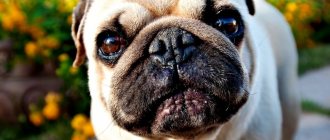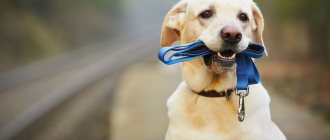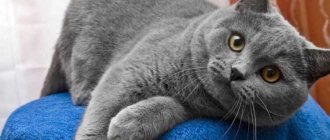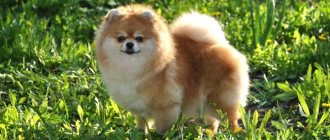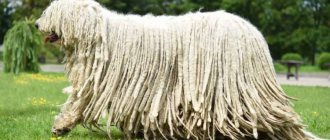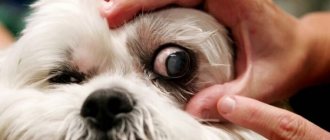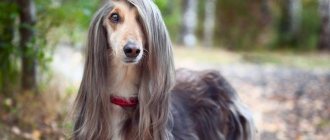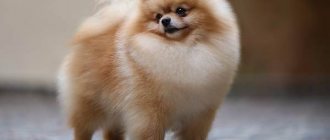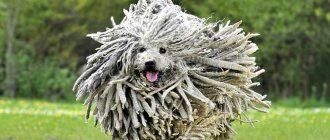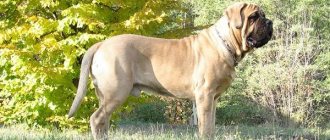When deciding to get a certain breed of dog, few people think about whether it will shed. And this is one of the key points, since excessively falling hair can be a difficult challenge, especially if the animal lives in an apartment. There are dogs that don't shed. This is an ideal option for those who do not want or cannot deal with pet hair flying everywhere.
If your pet sheds a lot, it can be a real nightmare for the household.
Are there dogs that don't shed?
There are no non-shedding dog breeds. Even a dog without hair has hairs on its face and periodically they are replaced by new ones, which means the old ones need to fall out. When it is said that dogs do not shed, they mean low levels of hair loss. But it doesn’t happen that shedding is completely absent.
All dog breeds that do not shed are divided into 4 types, depending on their coat type:
- Hairless - Chinese Crested, Mexican Hairless dogs. These breeds have a minimal amount of hair, so the process of hair loss will simply not be noticeable.
- Wire-haired dogs - terrier, Jack Russell, dachshund. Despite the soft undercoat, the coat itself of these breeds is very hard, so it practically does not fall out.
- Curly breeds - poodle. Hairs curled into small ringlets are not prone to falling out. But such dogs have another problem - their hair quickly becomes matted if it is not brushed regularly.
- Long-haired dogs - Yorkies, are characterized by minimal undercoat, and the hair growth cycle lasts about 8 months, so hair loss goes unnoticed.
Additional Information! In dogs with coarse hair, due to the lack of a natural process of changing hairs, trimming is necessary - plucking them. You can do this yourself or contact a groomer.
Trimming can be called an artificial process of changing coat
Yorkshire Terrier
Small Yorkies with cute faces fit into handbags and look cute on laps, but their small size creates a ton of difficulties. Their fine hair has a texture more similar to human fur than other types of fur, so it won't make you sneeze. But be careful, Yorkies' coats do require regular brushing and grooming to keep them mat-free and silky soft.
List of non-shedding breeds
Non-shedding dogs are a myth. But low-shedding animals, in which this process is not noticeable at all, do exist. And these are not only decorative breeds, but also animals of quite impressive size.
Small dogs
In addition to the absence of excessive hair loss, one of the pleasant features of non-shedding pets is that the dog is odorless. These animals include the following breeds:
- The Yorkshire Terrier is a companion dog that gets along well with all family members. Height from 15 to 17 cm, weight from 2 to 3.2 kg. Does not require special care. It is enough to get a haircut once every few months.
- Maltese lap dog - height at withers from 20 to 25 cm, weight from 3 to 4.5 kg. Sheds little due to the lack of undercoat.
- Brussels Griffon - height 17-20 cm, weight from 3 to 7 kg. The fur does not come out, but it requires periodic plucking.
- Shih Tzu - grows up to 27 cm, weighs from 4 to 8 kg. The coat is thick and requires frequent brushing and bathing.
- The Chinese Crested is a dog with hair instead of fur. Height up to 33 cm, weight up to 5.5 kg. Hair grows on the paws and head, although there is a type of breed that is completely covered with hair. Requires careful hygienic care, because the wool tends to get tangled.
Additional Information! For miniature breeds, it is enough to trim them once every 2-3 months to keep their coat in good condition.
The lapdog is a unique example, despite its long hair, it does not shed
Average
Not only a small decorative dog is distinguished by the absence of falling hairs and an unpleasant odor. Such characteristics are also characteristic of medium-sized animals. Names of the most common breeds:
- poodle;
- Basenji. An interesting feature of the breed is the absence of barking, which is why it is called the “African silent one”;
- Peruvian bald - the skin is covered with barely visible fluff;
- Mexican Hairless - the breed consists of several subspecies, both quite large in size and very miniature;
- Portuguese Water Dog - no shedding hair, but needs trimming.
Medium-sized dogs that do not smell like dogs, regardless of the type of coat, periodically change hairs, but they fall out so little that it goes unnoticed.
Big dogs
Many people think that large dogs are smelly and shed a lot. But that's not true. Therefore, when choosing a puppy, you should know which dogs do not shed but still have thick hair:
- Tibetan Terrier;
- Irish Wheaten Terrier;
- Italian greyhound;
- fox terrier;
- Scottish Terrier.
Additional Information! Surprisingly, the Komondor breed, which is distinguished by its incredibly thick and long hair curled into dreadlocks, is not prone to hair loss at all.
It's hard to believe that the Komondor doesn't shed
Schnauzer
| Origin: | Germany |
| Dimensions: | Height 36-51 cm, weight 5-43 kg depending on the type |
| Character: | Devoted, vigilant |
| Where used: | Hunting |
| Lives: | 7-16 years depending on the type |
| Color: | Black, white, silver, chocolate, black with ash |
It's hard to believe, but shaggy schnauzers hardly shed. There are several subspecies of the breed, all of them differ in size. But this is perhaps their only fundamental difference. The animals were bred for hunting and have long established themselves as faithful assistants in this matter.
Despite their cute appearance, schnauzers are vigilant animals that are always ready to defend their owner. They quickly become attached to the family and are generally very scrupulous. Representatives of this variety must be trained from childhood, otherwise you may end up with an uncontrollable dog.
Loading …
Physiology of the molting process
Any dog with hair sheds. This is a normal, physiological process. Wools have their own growth phase, the duration of which also varies for different breeds. Dead or damaged hairs periodically die off, being replaced by new, young and strong ones.
Seasonal shedding, which occurs twice a year - in spring and autumn, is explained by temperature changes. In the spring, when it gets warmer, the animal's body begins to shed the old undercoat so that lighter hair grows in its place. In autumn, before the winter cold, the reverse process occurs - light hairs are replaced by warm and thicker ones, which can protect the animal from frost.
Daily brushing will help your hair renew itself faster and make it easier to get through this period.
Devon Rex
The description of the breed is in many ways similar to the previous version. A distinctive feature is the unusual shape of the head, reminiscent of a heart. The ears are large and widely spaced. The Devon Rex's coat is also wavy and incredibly pleasant to the touch. You constantly want to stroke such a pet, cuddle it, and hold it on your lap.
By nature, the cat is very active and inquisitive. Not a single event in the house escapes her attentive eyes. If you want to have a naughty friend nearby, then you can't go wrong by choosing a Devon! Owner reviews are purely positive. Many enthusiastically compare their pet to a little monkey, and also note its high intelligence.
Types of hair in dogs, their properties
In total, there are 6 types of dog hair, depending on the length and structure of the hair:
- medium length – shepherd dogs, chihuahuas, petit brabançons;
- long-haired - Afghan hounds, some subspecies of dachshunds, collies, toy terriers;
- short-haired or smooth type - English bulldog, bully, bull terrier, basenji;
- curly type – lapdogs, poodle;
- wirehaired - dachshunds, fox terriers, schnauzers;
- exotic type of coat - Mexican Hairless, Chinese Crested.
Additional Information! Dogs with an exotic coat type appear bald only in appearance. Their skin is covered with light, barely visible down.
Common mistakes made by owners
The most common errors:
- the animal is limited in its ability to move freely around the apartment;
- The dog is not nearby when the front door opens.
Standard everyday situation. Before opening the door, the owner locks his animal in the back room and only after that allows the guest into the room.
If you cannot influence your pet using voice commands and the only way out is to isolate it in a room, then there are problems with training. What is the use of a locked dog?
In a moment of danger, all she can do is bark through the keyhole. The dog's place is in the hallway. It should always be near the front door. Even if you plan to go out for 5 minutes to take out the trash, always take your dog. Most attacks in city apartments occur within this short period of time.
Regarding guard breeds that guard suburban areas. A security guard must always patrol his territory! Try not to confine an animal unless absolutely necessary. Think in advance about how the dog can easily enter the house if necessary. Remember, guard animals must have complete freedom of movement, otherwise, what good are they?
And finally, in order for your pet to perform its duties efficiently and conscientiously, love and respect it. Only by earning the love of a dog will you receive not only a guard, but also a devoted friend for the whole family.
The nature of dog hair allergies
People who are allergic to wool think that it is enough to buy a pet that does not shed and then there will be no reaction. But that's not true. In addition to the wool itself, as a factor provoking an allergenic response in the body, skin particles and the secretions it produces can irritate the mucous membranes.
Particles float in the air, land on your hands, and are transferred to your face. Some dog breeds are slobbery, and their saliva can also cause allergies. The same applies to cats, some breeds of which are only conditionally called hypoallergenic; it is better not to be “friends” with them for people with asthma.
Purchasing a hairless dog is not a guarantee that an allergy sufferer will not have a negative reaction.
Scottish Terrier
You may know the adorable and individual Scottie from the Disney classic Lady and the Tramp, but independent and sometimes stubborn Scotties also make great pets. They were originally bred to be fierce hunters, and their thick, weather-resistant coats provided them with protection in any climate. Today, their dignified beard will probably spend most of their time gracing your couch.
Features of caring for non-shedding dogs
Keeping dogs whose hair does not fall out is not much different from hygiene procedures for actively shedding pets. Even the highest quality wool, unique in its structure, can be spoiled if it is not properly cared for:
- Bathing. Even those breeds that do not smell like dogs will begin to emit an unpleasant odor if water procedures are not carried out. The reason for the odor is the production of a protective secretion by the skin. Sebum is especially produced in those breeds that have very short hair. The frequency of water treatments depends on the characteristics of the breed. Some pets need to be bathed every week, while others need to be bathed no more than once every few months.
- Combing is a mandatory procedure for dogs, especially for those with curly hair, as it is prone to the rapid formation of tangles. The shorter the hair, the less frequently combing is done. If for long-haired dogs the procedure needs to be carried out at least every other day, then for smooth-haired dogs - once a week.
- A haircut. Long-haired dogs are sometimes easier to care for than pets with curly or coarse hair. This is explained by the fact that the fur of such breeds is not capable of renewing itself. In order for the fur coat to be replaced, it must be cut and plucked.
Due to the fact that the wool is not renewed over time, it may lose its attractive appearance and become dull. To prevent this from happening, in addition to updating haircuts, you need to monitor the dog’s internal health. In winter, it is recommended to give your pets vitamin and mineral complexes.
The emphasis is on vitamins A, B, E and D, they have a positive effect on the condition and appearance of the coat and skin.
There are no dogs that don't shed at all. There are simply breeds that do not have an undercoat, so the loss of individual hairs remains unnoticeable. But caring for such pets must be careful. Combing, bathing and trimming are measures that will help the coat renew itself.
Bedlington Terrier
Bedlington Terriers grow distinctive tufts of fur on the top of their heads, giving the cute breed a lamb-like appearance. These gentle, cuddly terriers make excellent guard dogs and partners. Professionals spend a lot of time styling curly dog show coats to achieve the perfect result. If you just want a cozy pet, you can opt for a low-maintenance short haircut instead.
Irish Water Spaniel
The Irish Water Spaniel is a dog with a dense, stocky body and thick coat with almost no undercoat. This is an exception among spaniels, which tend to shed their hair. Their character is active and mobile, their intelligence is developed, like all hunting breeds. Such dogs need long walks near bodies of water, as they love to swim.
American Pit Bull Terrier
The American Pit Bull Terrier, or pit bull, is a fighting breed bred in the USA by crossing a Staffordshire terrier and a bulldog. External features: massive body, large powerful jaw, short tail, shiny, tight-fitting coat. Thanks to their menacing appearance, excellent sense of smell and strong-willed character, pit bulls are accepted into service in the police, armed forces and other paramilitary units. Pit bull terriers are prone to sudden aggression, so at an early age it is necessary to take the puppy to socialization courses. But, in any case, having such a pet in a family where small children live is strictly prohibited, in order to avoid injury. Americans are not high maintenance. The main thing is to bathe the dog with baby soap or a special product 1-2 times every 3 months, and also wipe the ears and eyes with a damp cotton pad once every 3 days.
pitbull
Griffons
Griffons are small, affectionate indoor pets. The hypoallergenic breed is extremely good-natured and playful. The dog has coarse hair that needs to be trimmed regularly. In order not to disturb the structure of growing hair, dying hairs that become especially hard are plucked out. These are excellent watchdogs without the habit of barking in vain. They can become friends for children because they are not aggressive.
